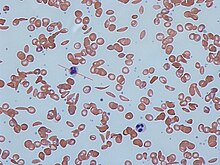
Back اعتلال الهيموغلوبين Arabic Hemoglobinopatia Catalan Hämoglobinopathie German Hemoglobinopatía Spanish هموگلوبینوپاتی Persian Hémoglobinopathie French Emoglobinopatia Italian 혈색소병증 Korean Hemoglobinopathie Dutch Hemoglobinopatia Polish
| Hemoglobinopathy | |
|---|---|
| Other names | Hemoglobinopathies |
 | |
| Red blood cells from a person with sickle cell trait | |
| Specialty | Hematology |
Hemoglobinopathy is the medical term for a group of inherited blood disorders involving the hemoglobin, the protein of red blood cells.[1] They are single-gene disorders and, in most cases, they are inherited as autosomal co-dominant traits.[2]
There are two main groups: abnormal structural hemoglobin variants caused by mutations in the hemoglobin genes, and the thalassemias, which are caused by an underproduction of otherwise normal hemoglobin molecules. The main structural hemoglobin variants are HbS, HbE and HbC. The main types of thalassemia are alpha-thalassemia and beta thalassemia.[3]
The two conditions may overlap because some conditions which cause abnormalities in hemoglobin proteins also affect their production. Some hemoglobin variants do not cause pathology or anemia, and thus are often not classed as hemoglobinopathies.[4][5]
- ^ CDC (2019-02-08). "Hemoglobinopathies Research". Centers for Disease Control and Prevention. Retrieved 2019-05-05.
- ^ Weatherall, D. J.; Clegg, J. B. (2001). "Inherited haemoglobin disorders: An increasing global health problem". Bulletin of the World Health Organization. 79 (8): 704–712. PMC 2566499. PMID 11545326.
- ^ "Hemoglobinopathies and Thalassemia". medicalassistantonlineprograms.org/. Archived from the original on 2015-01-09. Retrieved 2013-11-07.
- ^ "Hemoglobin Variants". Lab Tests Online. American Association for Clinical Chemistry. 2007-11-10. Retrieved 2008-10-12.
- ^ Huisman THJ (1996). "A Syllabus of Human Hemoglobin Variants". Globin Gene Server. Pennsylvania State University. Retrieved 2008-10-12.
© MMXXIII Rich X Search. We shall prevail. All rights reserved. Rich X Search